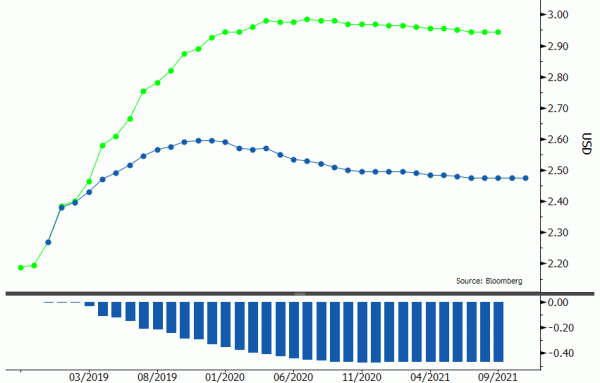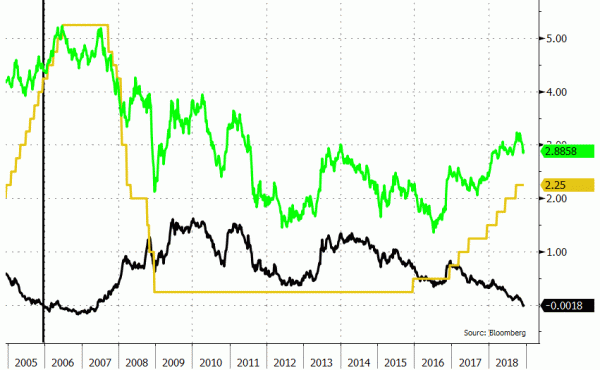- Fed’s view contrasts strongly with market thinking
- Inverse yield curve points to end growth/monetary cycle
- 2019 median rate projection key for market reaction
- We expect Fed to remain more hawkish, sticking to 3 hikes next year
The final Fed meeting of the year is expected to deliver a fourth rate hike this year, from 2%‐2.25% to 2.25%‐2.50%. The current state of the US economy warrants this next step in the US central bank’s normalization process. Fed chair Powell recently (Dec 6) said he was happy to report that the economy is currently performorming very well overall, with strong job creation and gradually rising wages. The US unemployment rate fell to 3.7%, the lowest level since 1969, and the Fed’s preferred inflation gauge, the PCE deflator, fluctuates between 2% Y/Y and 2.3% Y/Y since March. This week’s expected rate hike will lift the policy rate close to neutral levels. Fed governors guesstimates about this inherently uncertain concept ranged between 2.5% and 3.5% in the September projections.
Fed forecasts vs market expectations
Unlike the rate hike consensus for Wednesday, there’s a lot more uncertainty on how Fed governors think 2019 will look like. The median of Fed governors’ September rate forecasts suggested three more rate hikes. The balance of risks shifted throughout the year from stepping up the tightening cycle because of the risk of an overheating economy to slowing down the cycle because of the risk of killing the expansion. However, we don’t expect dramatic downgrades in Fed governors’ growth/inflation scenario since September and therefore think that the 2019 median rate forecast will remain unchanged (i.e. 3 hikes). Risks are clearly tilted to the dovish side and we think that the Fed will acknowledge augmented downside risks.
The Fed’s view contrasts strongly with market pricing. Rate hike expectations peaked in the wake of Fed Chair Powell’s October 3 Q&A session with PBS. He said that “interest rates are still accommodative, but we’re gradually moving to a place where they’ll be neutral – not that they’ll be restraining the economy. We may go past neutral. But we’re a long way from neutral at this point probably”. The market implied probability of sticking with quarterly rate hikes until June next year peaked above 40%. Currenly, it stands below 15%. Even the probability of a March 2019 rate hike fell below 50%.
Fed Funds forward curve on Oct 5 (green) and Dec 14 (blue): significant dovish repositioning
This dovish repositioning occurred as Fed governors tried to correct Powell’s slip of the tongue which hit riskier assets (stock markets, HY bonds) particularly hard. Additionally, markets fear that the US economy’s tailwinds, which caused economic outperformance vs the rest of the word this year, might turn into headwinds next year. Global growth is slowing abroad, the sugar rush of US President Trump’s fiscal stimulus is fading away and monetary policy will no longer be accodomative. The real Fed Funds rate turned positive in September for the first time this cycle and the Fed is draining excess liquidity by rolling off its balance sheet. This roll‐off hit maximum speed ($50bn/month) since the start of Q4 2017. There’s no indication whatsoever that the Fed is willing to review this roll‐off policy.
The US yield curve inverted between 2y5y and 3y5y. The 2y10y yield spread, often regarded as precursor of a recession in case of inversion, fell to an 11 bps cycle low. The last “false” recession signal from an inverse US yield curve dates back to 1967. The recession then kicks in with an average time lag of about 18 months. It’s important to bear in mind that an inverse yield curve doesn’t mean an immediate stop to the Fed’s tightening cycle. The Fed conducted 4 more 25 bps rate hikes after the yield curve inversion at the end of 2005 with US yields increasing more than 50 bps in a more or less parallel shift across the curve.
Fed Funds rate (yellow), US 2y5y yield spread (black) and US 10y yield (green)
This strong market signal shouldn’t be ignored nor overinterpreted when forecasting next year’s Fed policy path. We embrace the idea of a pause in the tightening cycle as policy rates enter neutral territory. Several Fed governors have different opinions, but they reach the same conclusion. Some worry about the eco outlook, some argue that the NAIRU is lower than expected, suggesting more room for growth without inflation spiraling out of control, other stress the symmetric inflation target allowing some overshoot after years of undershooting and a couple suggest that monetary policy changes impact the economy with a 12‐month time lag. All those arguments warrant a pause in the tightening cycle next year. That’s why the Fed will probably drop its forward guidance calling for “more gradual rate hikes”. They’ll replace it by a more data dependent guidance, leaving space to stop quarterly rate hikes if economic growth e.g. grinds to a halt. Given the current strength of the US economy and taking into account a new reaction function of the Fed, we expect 2019 rate hikes to be front‐ rather than backloaded (higher probability of deteriorating eco data). Bear in mind that every meeting is a live one next year with Chair Powell addressing the press on every occasion.
The rate projections for the 2020‐2021 period risk becoming a self‐destroying spiral for the Fed. We argued before that dropping the dots could be the final chapter in the Fed’s revision of its communication strategy. The 2020 median (1 additional hike to 3%‐3.25%) will probably stay unchanged even if the average of projections could fall somewhat. The 2021 median rate projection (unchanged vs 2020) is at risk of declining from 3.25%‐3.5% to 3%‐3.25% and implying a rate cut. In such a scenario, the Fed aligns with the sign from the recent curve inversion and actually indicates that the end of the monetary cycle is nearby.
If the Fed surprises on the dovish side for 2019 (2 hikes instead of 3 hikes), we expect median projections for 2020 and 2021 to decline as well (both from 3.25%‐3.50% to 3%‐ 3.25%).
2019 forecast key for trading
The Fed will remain more hawkish than current market expectations. The 2019 projection is key for short term rates and the dollar. Sticking with three rate hikes will lift the front end of the US yield curve, further inversing the 2y5y part and supporting the dollar. EUR/USD 1.1187/1.1217 is key support. Sticking with this pace of policy normalization might hurt US stock markets though and cause risk aversion. The long end of the US yield curve won’t be affected much by monetary policy thinking. The odd thing about the past two month’s decline of the US 10‐ yr yield is that it was entirely driven by falling inflation expectations (linked to oil prices). The US 10‐yr real rate is only 8 bps below its cycle peak (1.15%). Tracking activity/inflationary data and risk sentiment might therefore be more important to determine near term moves at the long end of the US curve. If the 2019 dots indicate only 2 rate hikes next year, markets will move in the similar direction, but magnitudes will be smaller and moves might not last. This scenario will benefit risk sentiment in general as well. The two major corrections on US stock markets occurred this year on fears that the Fed might step up the tightening cycle (February & October).















